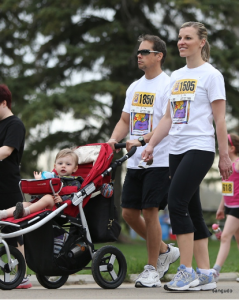14 Equality for Mothers in the Canadian Workforce
Kate Millar
Since a young age I have dreamed of being a mother, and having children is something that continues to be very important to me. However, I do not want my only identity to be that of a mother – I also want a career. I do not think these two aspirations should be mutually exclusive. A woman should not have to choose between raising a family and career advancements .

The Women’s Rights Movement has been fighting for equality in the workforce for a long time, and the movement has made huge strides to create equal opportunities for men and women in the workforce in the last century. According to the Labour Force Survey (LFS), in 2015, 82% of women aged 25 to 54 participated in the labour market. This is compared to 65.2% in 1983 and only 21.6% in 1950 (Moyser, 2017). The increased prevalence of females in the workforce can be attributed to more progressive views on gender roles, technological advancements that reduce the time of household chores, families with fewer children, and increased employment opportunities for women in the service industry (Statistics Canada, 2018). By including women in the workforce, the labour market is more productive thus strengthening the economy and benefiting the entire population.
As important as it is to recognize the advancements of gender equality in the workforce, it is equally important to acknowledge that discrimination on the basis of sex still exists in the workplace. In fact, according to the Human Rights Tribunal of Ontario, 25% of the complaints in 2013-2014 were on the grounds of sex, pregnancy and gender identity (McDonald, 2015). The Canadian Human Rights Act prohibits discrimination related to pregnancy. Negative treatment and harassment, refusal to hire or promote, and termination of employment on the basis of pregnancy are all against the law under the Act. Only women can become pregnant, and therefore, pregnancy discrimination is a form of sex discrimination (CHRC, n.d).
In 2015, Global News covered a story about Yvette Wratten, a 27-year-old woman in Georgetown, Ontario, who was fired from her job at Topper’s Pizza after her employer heard rumours about her pregnancy. Wratten, took her case to court and was awarded $20,000, but for Wratten it was about more than the money, it was about advocating for women’s right in the workplace. The human rights lawyer on this case, De Bousquet, told Global News that this case was somewhat unusual in that the woman was terminated immediately after the employer found out about her pregnancy. More commonly, the lawyer explains, companies will find loopholes and terminate women during their maternity leaves, and the employers will claim that the termination was the result of the restructuring of the company. (McDonald, 2015)
Sex discrimination towards women on the basis of reproduction continues after childbirth and follows women throughout motherhood. It is believed that the ‘motherhood penalty’ plays a crucial role in the pay gap between men and women in many industrialized countries, including Canada (Howard, 2018). The ‘motherhood penalty’ was coined by sociologists who contend that in the workplace mothers are systematically disadvantaged when it comes to pay, perceived competence and benefits as compared to women without children (Khan et al., 2014). In Canada, on average, women with children earn 12% less than women without children, and this gap widens with the number of children (Zhang, 2009). While women with children earn less money, a recent study from UBC found that white men in Canada earn a premium for having children (Fuller & Cooke, 2018). Clearly, mothers and fathers are held to different standards in the workplace.
A study conducted by Fuegen et al. (2004) investigated how parenthood interacts with gender stereotypes to affect decisions involving workplace competence. The participants of the study evaluated a job applicant who was either male or female and either single or married with two children. The results of this study revealed that parents were perceived as less achievement-oriented and less committed to employment than non-parents. Interestingly, fathers were held to more forgiving standards than both mothers and childless men (Fuegen et al., 2004). Research in this field also demonstrates that working women trade perceived competence for perceived warmth when they become mothers. Men, on the other hand, do not suffer the same trade-off when they become fathers, retaining perceived competence and gaining perceived warmth (Cuddy & Fiske, 2004). As a result of the negative stereotypes mothers face in the workplace, many working mothers shorten their maternity leaves and bend over backwards to prove to their employers that they are committed to their professions.
For some women, sport is their workplace, and women in professional sport are not exempt from discrimination on the basis of motherhood. For that matter, until relatively recently, women were not allowed to participate in many high-level sports, because society believed that it could impede a women’s ability to bear children (Appleby & Fisher, 2009). These assumptions are wrong. A woman can participate in sports such as running and maintain her ability to bear children. In fact, my favourite Canadian runner Melissa Bishops-Nriagu, gave birth to her daughter Corinne in the summer of 2018 and she is currently training for the Tokyo Olympic Games. However, pregnancy in the middle of an elite athletic career remains taboo and many athletic governing bodies are unsupportive of women taking breaks from training during the ‘peak’ of their career (Darroch et al., 2019). In fact, taking this misconception one step further, pregnancy is considered an ‘injury’ amongst most Canadian National Sport Organizations (NSOs).

Hilary Stellingwerff, a Canadian mid-distance runner competed in the 2012 Olympics Games, and two years later she gave birth to her son. Due to her pregnancy, Stellingwerff applied for an injury card for the 2014-2015 carding cycle with Athletics Canada, meaning she continued to receive funding from the Athlete Assistance Program (AAP). Upon her return to training, Stellingwerff was diagnosed with a stress fracture in 2015 and applied for another injury card. However, Stellingwerff’s application to the 2015-2016 AAP was denied by the National Team Committee (NTC) on the basis that an athlete can only receive an injury card once and she had used it for her pregnancy the year prior. Stellingwerff felt that this was a human rights issue (and I certainly agree!). Her pregnancy was considered an injury. Female athletes can either be pregnant or be injured – but injury is clearly not a choice. Not to mention: pregnancy is not an injury, but instead, it is a natural state of being for a woman when she chooses it. I am bewildered that in the 21st century NSOs continue to treat pregnancy like an injury. This is clearly sex discrimination, because no male has ever had to use his one injury card when in the natural state of pregnancy. Stellingwerff took her case to the Sport Dispute Resolution Centre of Canada (SDRCC) and won her case (Darroch et al., 2019). Her funding, however, was not resumed immediately because Athletics Canada was not confident that she could compete at the Olympic level after her pregnancy. Stellingwerf proved them wrong by running a personal best in a five-kilometre road event eight months postpartum and meeting the Olympic standard for the 1500m event. Stellingwerf had her funding reinstated in time for the 2016 Olympics in Rio. (Giddens, 2020)
Since Stellingwerf’s case, Athletics Canada has replaced the term ‘injury card’ with ‘health card’, encompassing more than just physical injuries and they have updated section 8.14.5 of their policy: “Athletes may be nominated for Health Card status due to pregnancy more than once.” (Giddens, 2020). Strong women and advocates such as Hilary Stellingwerf are pioneers in the movement against pregnancy discrimination in elite sport, and new mothers and athletes such as Melissa Bishops-Nriagu continue to advocate for mother’s rights in sport. Mothers belong in professional sport, and policies such as injury cards need to be dismantled. Policy needs to continue to evolve to better support pregnancy and motherhood in the workplace.
As a nation, Canada must reflect on current policies that allow discrimination against women and mothers in the workplace and contribute to the pay gap between women and men. One strategy would be to reimagine the maternity and parental leave policy. According to the 2010 Survey of Young Canadians, among children ages 1 to 3 years whose mothers were working before their birth, 90% of mothers reported taking a leave after their birth. In contrast, only 26% of Canadian fathers took a leave after the birth of their child. It is important to note that these statistics are derived from a sample of participants from all of the Canadian provinces except for Quebec as it has its own maternity and parental leave policies (Findlay & Kohen, 2015). In Canada, either parent can take the parental leave, however, as the above statistic illustrates more often than not, it is the mother who takes the leave. This decision is likely driven by the social discourse that the mother is the primary caregiver and ‘should’ be the one who steps back from her career. I would argue that Canada consider the approach taken by Iceland. Iceland provides equal maternity and paternity benefits in efforts to promote gender equality. New parents are provided with 10 months of paid leave where each parent is entitled to 4 months of leave and the additional 2 months can be allocated as desired (European Commission, n.d.). By designating 4 months of leave to each parent, fathers find themselves sharing more of the caregiving role. Additionally, both mothers and fathers take more or less equal leaves from work, subsequently reducing the effect of the motherhood penalty. In January 2021, Iceland will be extending the parental leave benefit to 12 months, with 5 months allocated to each parent. As a nation, Canada must reflect on its current regulations, policies, and laws in order to entice change and eradicate the discrimination against women and mothers in the workplace. Women can choose to be mothers, but they should also have the choice to be active members in the workforce, and these decisions should not be mutually exclusive.

References
Appleby, K.M., & Fisher, L.A. (2009). “Running in and out of motherhood”: Elite distance runners’ experiences of returning to competition after pregnancy. Women in Sport and Physical Activity Journal, 18(1), 3-17. https://doi.org/10.1123/wspaj.18.1.3
CHRC (n.d). Pregnancy & human rights in the workplace – policy and best practices. https://www.chrc-ccdp.gc.ca/eng/content/policy-and-best-practices-page-1
Cuddy, A.J., & Fiske, S.T. (2004). When professional become mothers, warmth doesn’t cut the ice. Journal of Social Issues, 60(4), 701-718. https://doi.org/10.1111/j.0022-4537.2004.00381.x
Darroch, F.E., Giles, A.R., Hillsburg, H., McGettigan-Dumas, R. (2019). Running from responsibility: Athletic governing bodies, corporate sponsors, and the failure to support pregnant and postpartum elite female distance runners. Sport in Society, 22(12), 2141-2160. https://doi.org/10.1080/17430437.2019.1567495
European Commission. (n.d.) Iceland – pregnancy and childbirth. https://ec.europa.eu/social/main.jsp?catId=1114&langId=en&intPageId=5109
Findlay, L.C. & Kohen, D.E. (2015, November 27). Leave practices of parents after the birth or adoption of young children. Statistics Canada. https://www150.statcan.gc.ca/n1/pub/11-008-x/2012002/article/11697-eng.htm#a6
Fuegen, K., Biernat, M., Haines, E., & Deaux, K. (2004). Mothers and fathers in the workplace: How gender and parental status influence judgments of job-related competence. Journal of Social Issues, 60(4), 737-754. https://doi.org/10.1111/j.0022-4537.2004.00383.x
Fuller, S., & Cooke, L.P. (2018). Workplace variation in fatherhood wage premiums: Do formalization and performance pay matter? Work, Employment and Society, 32(4), 768-788. https://doi.org/10.1177/0950017018764534
Giddens, D. (2020, May 10). Athlete moms and the fight for funding. CBC Sports. https://www.cbc.ca/sportslongform/entry/mother-athletes-fighting-for-funding
Howard, J. (2018, September 24). No, moms, the gender gap is not on us. Canadian Women’s Foundation. https://canadianwomen.org/blog/no-moms-the-gender-pay-gap-is-not-on-us/
Kahn, J.R., García-Manglano, J., & Bianchi, S.M. (2014). The motherhood penalty at midlife: Long-term effects of children on women’s careers. Journal of Marriage and Family, 76(1), 56-72. https://doi.org/10.1111/jomf.12086
McDonald, C. (2015, August 12). Georgetown, Ont. Women wins human rights case after firing over pregnancy. Global News. https://globalnews.ca/news/2162352/georgetown-ont-woman-wins-human-rights-case-after-firing-over-pregnancy/
Moyser, M. (2017, March 9). Women and paid work. Statistics Canada. https://www150.statcan.gc.ca/n1/pub/89-503-x/2015001/article/14694-eng.htm
Statistics Canada. (2018, May 17). The surge of women in the workforce. https://www150.statcan.gc.ca/n1/pub/11-630-x/11-630-x2015009-eng.htm
Zhang, X. (2009, March). Earnings of women with and without children. Statistics Canada. https://www150.statcan.gc.ca/n1/pub/75-001-x/2009103/article/10823-eng.htm

